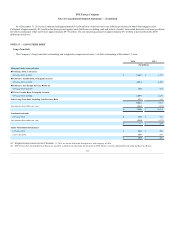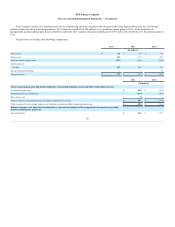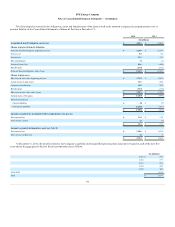DTE Energy 2014 Annual Report Download - page 92
Download and view the complete annual report
Please find page 92 of the 2014 DTE Energy annual report below. You can navigate through the pages in the report by either clicking on the pages listed below, or by using the keyword search tool below to find specific information within the annual report.
Contaminated and Other Sites — Prior to the construction of major interstate natural gas pipelines, gas for heating and other uses was manufactured
locally from processes involving coal, coke or oil. The facilities, which produced gas, have been designated as MGP sites. DTE Electric conducted remedial
investigations at contaminated sites, including three former MGP sites. The investigations have revealed contamination related to the by-products of gas
manufacturing at each MGP site. In addition to the MGP sites, the Company is also in the process of cleaning up other contaminated sites, including the area
surrounding an ash landfill, electrical distribution substations, electric generating power plants, and underground and aboveground storage tank locations.
The findings of these investigations indicated that the estimated cost to remediate these sites is expected to be incurred over the next several years. At
December 31, 2014 and 2013, the Company had $10 million and $8 million accrued for remediation, respectively. Any change in assumptions, such as
remediation techniques, nature and extent of contamination and regulatory requirements, could impact the estimate of remedial action costs for the sites and
affect the Company’s financial position and cash flows. The Company believes the likelihood of a material change to the accrued amount is remote based on
current knowledge of the conditions at each site.
In December 2014, the EPA released a pre-publication version of a rule to regulate coal ash. This rule is based on the continued listing of ash as a non-
hazardous waste, and relies on various self-implementation design and performance standards. The rule is still being evaluated and it is not possible to
quantify its impact at this time. DTE Electric owns and operates three permitted engineered ash storage facilities to dispose of fly ash from coal fired power
plants and operates a number of smaller impoundments at its power plants.
Gas
Contaminated and Other Sites — Gas segment, owns or previously owned, 15 former MGP sites. Investigations have revealed contamination related to
the by-products of gas manufacturing at each site. Cleanup of three of the MGP sites is complete and the sites were closed. We completed partial closure of
two sites in 2014. Cleanup activities associated with the remaining sites will be continued over the next several years. The MPSC has established a cost
deferral and rate recovery mechanism for investigation and remediation costs incurred at former MGP sites. In addition to the MGP sites, the Company is also
in the process of cleaning up other contaminated sites, including gate stations, gas pipeline releases and underground storage tank locations. As of
December 31, 2014 and 2013, the Company had $24 million and $28 million accrued for remediation, respectively. Any change in assumptions, such as
remediation techniques, nature and extent of contamination and regulatory requirements, could impact the estimate of remedial action costs for the sites and
affect the Company’s financial position and cash flows. The Company anticipates the cost amortization methodology approved by the MPSC for DTE Gas,
which allows DTE Gas to amortize the MGP costs over a ten-year period beginning with the year subsequent to the year the MGP costs were incurred, will
prevent environmental costs from having a material adverse impact on the Company’s results of operations.
Non-utility
The Company’s non-utility businesses are subject to a number of environmental laws and regulations dealing with the protection of the environment
from various pollutants.
The Michigan coke battery facility received and responded to information requests from the EPA that resulted in the issuance of a NOV in June 2007
alleging potential maximum achievable control technologies and new source review violations. The EPA is in the process of reviewing the Company’s
position of demonstrated compliance and has not initiated escalated enforcement. At this time, the Company cannot predict the impact of this issue.
Furthermore, the Michigan coke battery facility is the subject of an investigation by the MDEQ concerning visible emissions readings that resulted from the
Company self reporting to MDEQ questionable activities by an employee of a contractor hired by the Company to perform the visible emissions readings. At
this time, the Company cannot predict the impact of this investigation.
The Company received two NOVs from the Pennsylvania Department of Environmental Protection (PADEP) in 2010 alleging violations of the permit
for the Pennsylvania coke battery facility in connection with coal pile storm water runoff. The Company settled the alleged violations by implementing best
management practices to address the issues and repair/upgrade their wastewater treatment plant. The Company recently received a permit to upgrade its
existing waste water treatment system and is currently seeking a permit from the PADEP to further upgrade its wastewater treatment technology to a
biological treatment facility. The Company expects to spend $1 million on the existing waste water treatment system to comply with existing water discharge
requirements and to upgrade its coal pile storm water runoff management program. The Company will also spend up to an additional $13 million over the
next few years to upgrade the treatment technology to biological treatment to meet future regulatory requirements and gain other operational improvement
savings.
89
























